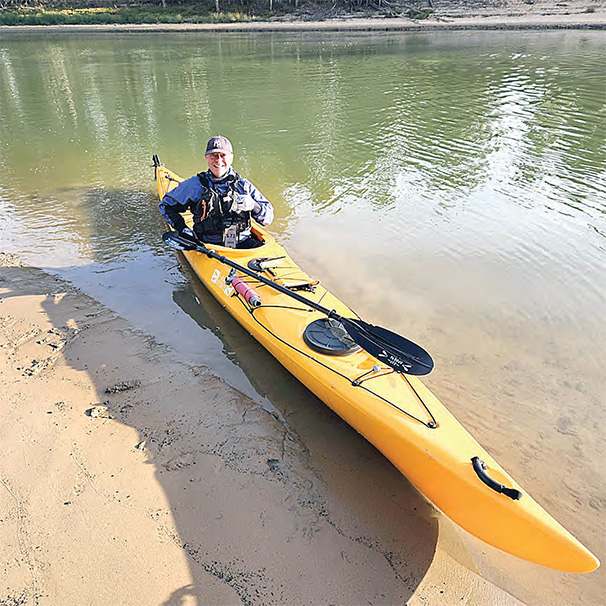Two men are planning to undertake separate journeys down Australia’s longest river to raise funds for charity.
Starting at Lake Hume, Peter Dixon from Wandiligong paddled down the Murray River in a kayak 15 years ago with his daughter Georgia and wife Helen, who was their support person.
After being married for 47 years, Helen died in March from pancreatic cancer after almost two years of treatment at the Albury Wodonga Regional Cancer Centre, which has inspired Mr Dixon to recreate his original trip in his wife’s honour and to raise funds for the centre.
He will depart on his 2500km trek down the Murray from Bringenbrong Bridge on September 1st this year and expects to arrive at the mouth of the river at Lake Goolwah in South Australia 10 weeks later. He has already raised more than $50,000 for the centre in the lead up to his paddling marathon.
Albury Wodonga Regional Cancer Centre Trust Fund manager, Andrew Mackinlay, said “It is pleasing to see that although it was a pretty tough time for Peter and his family, he feels like he still wants to give back and do the best he can to help support cancer services in the area.
“The drive that he’s got to do this is refreshing for us to see at the centre and we’re behind him all the way.”
Donations can be made online at give.awcancertrust.org.au/fundraisers/peterdixon.
In April 2026, Tony Pearce, the former Inspector-General for Emergency Management and current chair of the Emergency Services Foundation (ESF), will embark from Bringenbrong Bridge on an unsupported paddle to raise awareness of the mental health impacts of emergency work on Victoria’s 139,000 volunteer and paid emergency workers and to raise funds for the ESF.
“This journey will highlight the mental health challenges faced by those who serve our communities on the frontline,” Mr Pearce said.
“The ESF plays a vital role in supporting their wellbeing through sector-wide coordination and evidence-based programs.”
‘Tony’s Trek’ started in 2023, when he undertook a solo 1,506km trek over 50 days throughout the areas affected by the 2019-20 Black Summer bushfires. It started a community dialogue about emergency services mental health and raised $240,000 which was used to fund six pilot Residential Wellbeing Programs for volunteer and emergency workers suffering with their mental health.
In 2024 he and 25 emergency services colleagues trekked to Mt Everest base camp in Nepal, further raising awareness as well as $40,000 which contributed to funding the ESF Lived Experience Program.
‘Tony’s Trek’ 2026 – Paddle for Awareness will commence on April 12th at Bringenbrong and is expected to end at Lake Goolwah 55-60 days later.
“I am attempting to raise $50,000 to fund another Residential Wellbeing Program for more of our emergency workers suffering with their mental health as a result of protecting their communities,” Mr Pearce said.
“Along the way I will take every opportunity to shine a light on the hidden toll that emergency work takes on volunteers because the statistics are damning and we can and must do better.
“I have had enough of seeing colleagues take their lives due to their mental health battles and others consigned to a life of total misery after retirement.”
The mental health toll includes:-
- One-in-three emergency service workers experience high or very high psychological distress.
- 15 per cent of all Workcover mental injury claims come from emergency services workers.
- The average emergency worker mental health claim costs $389,000 against a Workcover scheme average of $244,000
- Only 37 per cent of emergency workers with a mental injury claim are back at work within six months which is well below the scheme average
- More emergency workers than ever before are unable to return to work at all.
“The really sad part about these statistics is that they only relate to those who have been diagnosed and are in the Worcover system,” Mr Pearce said.
“We know categorically that the as yet undiagnosed numbers are much higher.
“The solo journey down the Murray River will be both a physical and mental challenge for me, much like the daily experiences of our emergency workers.
“Along the way, I hope to connect with local communities, share stories of resilience and highlight the need for robust mental health resources and support systems. My aim is to inspire action and raise vital funds to enhance programs that promote wellbeing for our emergency services personnel.
“I am inviting everyone to support me on this journey, whether by following my progress, spreading the message or contributing to the cause.
“Let’s paddle together toward a future where we have mentally healthy people and workplaces across the emergency services sector.”
You can follow his journey and support him at www.facebook.com/groups/3954793511476192.
This article appeared in Corryong Courier, 17 July 2025.


